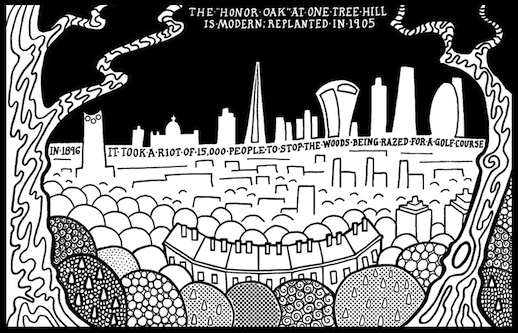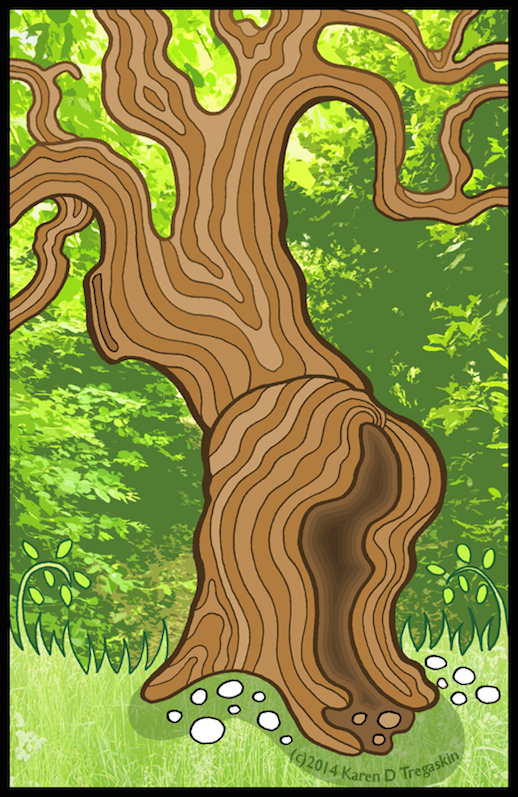Words and pictures by Karen D Tregaskin
15: One Tree Hill
The last leg of my walk cut through Camberwell Old Cemetery, then up through Honour Oak Park, up past St Augustine’s Church, to the very top of One Tree Hill, where I was rewarded with panoramic views of The City. The Honour Oak itself (the current incumbent is a modern replacement) was the boundary of an ancient Norman land tract that has come to be associated with Queen Elizabeth I, though in fact, she merely rested beneath it; there is no truth to the amusing story that she accidentally knighted the tree in a drunken haze. Due to its location high over London, it’s been the site of beacon fires, semaphore posts and gun emplacements, crumbling remains of which still litter the hillside. But the council’s signs bear witness to a different form of fragility: in 1896, the hilltop was fenced off, and scalped, the trees cleared for a private golf course. A hastily formed Committee launched legal objections, but in the meantime, the locals took more expedient measures. A 15,000 strong crowd rushed the hill, pulled down the fence and sung “Rule Britannia” before dispersing. Six days later, a full-scale riot of between 50,000 to 100,000 people sealed the land’s fate. In 1905 the park was secured with a Compulsory Purchase order by the council, the woods returned, and the astonishing views were preserved.
16: Ancient Oak
The oldest living thing I encountered on my walk. The trees of the Great North Wood themselves may be resilient, but ancient woodlands are still fragile. In recent decades, development has been blocked in Sydenham Hill and Dulwich Woods, but even this spring, the eastern end of Convent Woods was threatened by careless building work. In Streatham Common Woods, it may be necessary to fell some modern trees to preserve endangered acid grassland habitat, and a patch of wild Furze which has stood in that spot since the Middle Ages. (No one thinks of Furze as ancient, but there is Furze in Cornish hedges that pre-date the pyramids.) Individual woodlands may be preserved, but getting four London Councils, numerous local authorities and friends groups to agree on any action which considers the entire Great North Wood as a whole can be tricky. Greenery is disappearing from this city of trees at an alarming rate; during my research, a man from Lambeth Council told me that hundreds of trees and thousands of square meters of garden disappear from the borough every decade, replaced by decking and driveways. The Great North Wood may not be gone, lurking on in both managed woodlands and tiny scraps of uncleared borders, behind train tracks and between housing estates, but its future as a whole still requires safeguarding. It is not just the magnificent relict trees that are worth preserving, though it is humbling to stand beneath a 400-year-old oak like this. It is the entire ecosystem, from fungus and wildflowers, to foxes and butterflies, which resurrects the woods from mere ghosts to a living thing.
Ghosts of the Great North Wood archive.
For more illustrations, please visit Karen D Tregaskin’s Flickr / Tumblr/ Twitter

